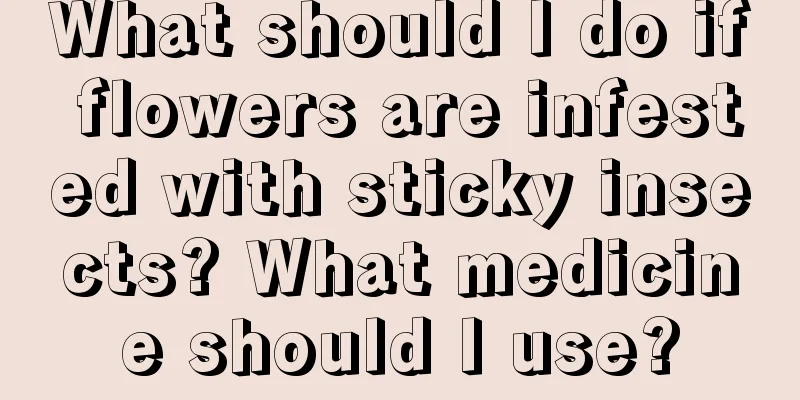What should I do if flowers are infested with sticky insects? What medicine should I use?

|
Plant bugs are common pests that often parasitize flowers, leaves, and stems. The reproductive capacity of sticky insects is very strong, and they will multiply in large numbers under high temperatures, so they must be prevented and controlled in a timely manner. So what should we do if flowers are infested with sticky insects and what medicine should we use? Let’s take a look with the editor below. 1. Symptoms of greasy insects on flowers Putty bugs are generally yellowish or brown in color, with an oval body covered in a sticky waxy secretion that makes them look like they are covered in a layer of putty. They often gather in the axils of flowers, on the undersides of leaves or on stems. The leaves of flowers infested by sticky insects will show symptoms such as yellowing, curling and wilting. 2. What should I do if flowers are infested with sticky insects and what medicine should I use? 1. Physical prevention ① Manual removal: Dip a cotton swab or fine-bristled brush in soapy water and gently wipe the insects on flowers, leaves and stems. Be careful to operate gently to avoid damaging the flowers. ② Rinse with cold water: Place the flowers under running cold water and rinse the leaves and flowers with water to wash away the insects. Focus on cleaning the leaf axils and undersides of leaves, as these are where gnats often hide. ③Spray with soapy water: Make a soapy water solution, mix an appropriate amount of soap in warm water, and use a spray bottle to spray on flowers, leaves and stems. Soapy water can break down the gnats' shells, causing them to suffocate and die. Be careful to spray evenly and make sure to cover the areas where the ants are. 2. Biological control Certain insects, such as ladybugs, aphids, and parasitic wasps are natural enemies of sticky insects. They will actively seek out and eat sticky insects, and their numbers can be controlled by introducing these natural enemies. Usually you can catch a few ladybugs and put them on the flowers, which will have a certain killing effect on the sticky insects. 3. Chemical control To treat the pests on flowers, you can also spray omethoate emulsion and malathion emulsion on the plants. It is best to dilute the agents with water before spraying to prevent the concentration from being too high and burning the roots. Generally speaking, this kind of chemical pesticide will cause certain harm to the plants themselves. Especially if you spray some chemical pesticides on plants grown at home, it will definitely cause certain harm to the human body itself. Therefore, it is recommended to make your own medicine at home. Dilute laundry detergent, urea and water in a ratio of 1:4:400. The medicine made in this way also has a good bactericidal and disinfecting effect. The above is an introduction to what to do if sticky insects grow on flowers and what medicine to use. If sticky insects grow on flowers, you can choose suitable organic insecticides , such as vegetable oil, orange peel extract, etc., and spray them according to the instructions. Organic pesticides have a better control effect on sticky insects and are relatively safe for plants.
|
<<: Should I water the money tree thoroughly? What should I do if I water it too much?
Recommend
How to take care of spider plants after they bloom
1. The characteristics of this plant First, we ne...
The correct way to water flowers with expired milk
Expired milk can be used to water flowers, which ...
Which month is suitable for planting open-field celery?
When to plant open-field celery The time for plan...
Will aloe vera freeze to death in winter?
Do plants freeze to death in winter? To answer th...
How to plant mint? Potted mint planting methods and precautions
There are many ways to propagate mint. When growi...
How to prune jasmine
Pruning branches and leaves of jasmine Forsythia ...
What diseases can allicin prevent and treat?
Ethylalicin is a moderately toxic fungicide . The...
Ten kinds of flowers that you can't grow at home
1. Euphorbia pilosa The white juice inside the Eu...
Garlic planting time and method
Garlic planting time Garlic is usually planted in...
Can Ginkgo trees be planted in Guangxi?
Can Ginkgo trees be grown in Guangxi? Ginkgo tree...
Clematis cutting method
Cutting preparation Psychology: Be fully prepared...
Cultivation methods and precautions of golden cypress
1. Maintenance methods 1. Water: In spring and su...
Can soy milk be used as fertilizer?
Soy milk water as fertilizer It takes a certain a...
Radish seedling planting method and time cultivation steps (technical points)
Suitable time for planting radish seedlings Radis...









